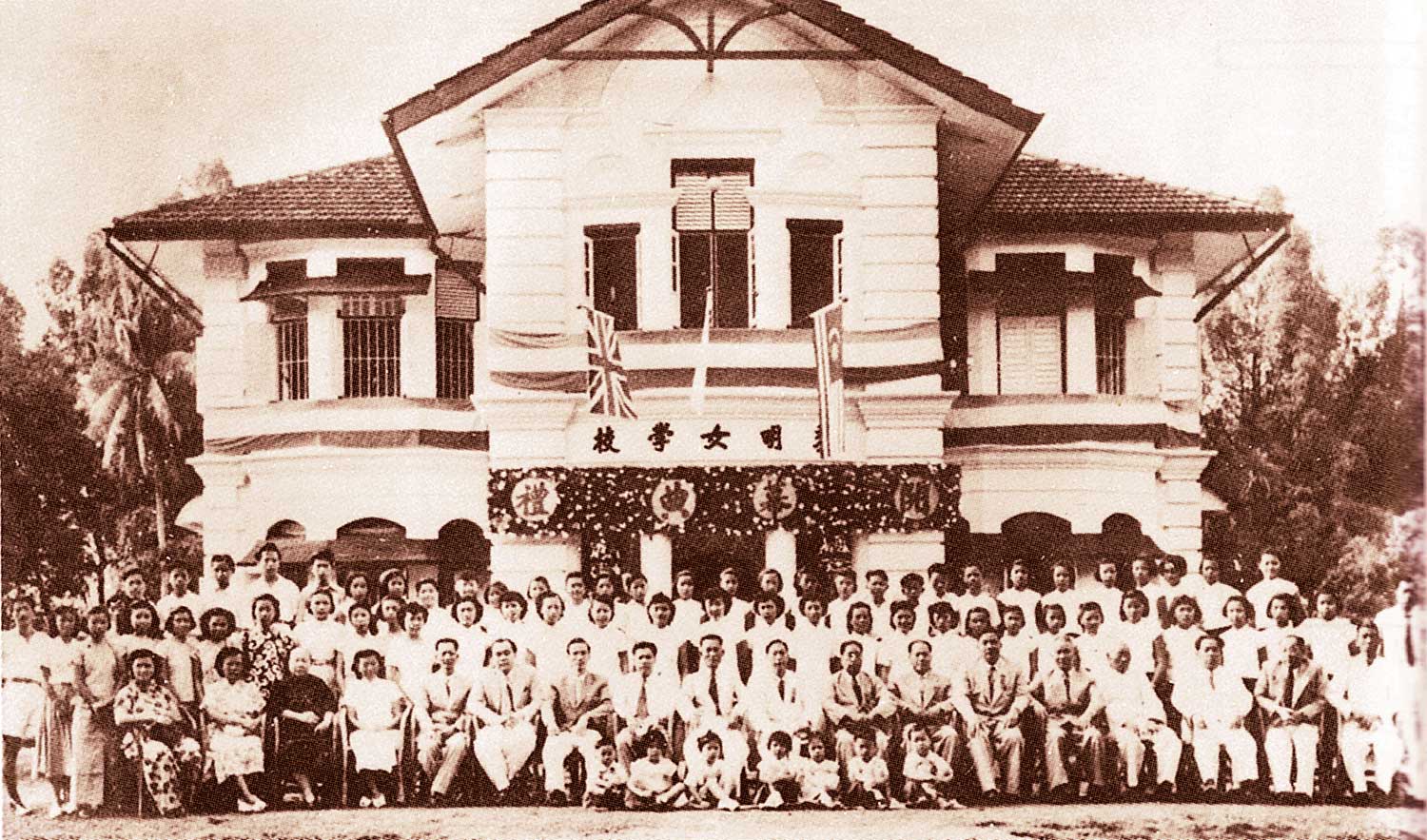The Engchoon Kuala Lumpur History Gallery






Establishment of
Chinese Primary Schools
In the early 20th century, people from Engchoon in Kuala Lumpur began to engage in educational work. From Wenlianggang Chinese Primary School (1919), Zhonghua Girls’ School (1924), Liming Girls’ School (1929), Cheras Nine Mile Chinese Primary School (originally known as Peizhi Primary School, established in 1934), Batu Cave Refugee Primary School (1935), Wenlianggang Minyi Primary School (1943), China Public School, National School (now closed), to Taoyuan Night School, Engchoon people played a significant role in the establishment and development of these schools. In addition, Engchoon people also made considerable contributions to the reopening of Kuncheng Girls’ Primary School after World War II.
Wenlianggang Chinese Primary School was the predecessor of Kuala Lumpur Zhonghua Independent High School. In 1919, leaders of the Fujian community, including Hong Qidu and Ye Yangqian from Nan’an, and Huang Zhongji from Engchoon, could not bear to see the many children in the areas from Batu Road to Wenlianggang wandering the streets without schooling. Therefore, together with Chen Bingkun, Xie Jianwu, Zeng Xinghan, and others, they initiated the establishment of Zhonghua School.
Kuala Lumpur Wenlianggang Zhonghua School was established in 1919, with Huang Zhongji being one of its key founders. The picture shows a group photo of teachers and students at the opening ceremony in 1921
Source: Provided by Centre for Malaysian Chinese Studies

Zhonghua Girls’ School, established in 1925 by the Selangor Hokkien Association, saw the involvement of leaders from the Kuala Lumpur Engchoon Association, including Hong Jincong, Huang Zhenxiu, Huang Zhongji, Chen Renruan, Chen Xiqi, Lin Shibang, Lin Bangling, and Yan Panghu
Source: Provided by Centre for Malaysian Chinese Studies

The National School was a Chinese primary school established by the Selangor Hokkien Association before World War II. Li Jiayao came to the Southeast Asia, initially teaching in Singapore before moving to Malaya. In 1929, he accepted an invitation to become the principal of the National School founded by the Selangor Hokkien Association. Many of the school’s board members were from Engchoon, including Chen Pengxiang, Chen Riqiang, Huang Zhongji, Huang Zhenxiu, and Lin Shiyin.
Liming Girls’ School was founded in 1929, initially located at buildings 2 and 4 on Hale Road. In the early years of school establishment, Engchoon people were less involved in the school’s affairs. In the early 20th century, the Kampong Baru area of Kuala Lumpur had a high concentration of Engchoon people, making Liming Girls’ School the closest Chinese primary school to Kampong Baru. Therefore, many Engchoon children attended Liming Girls’ School. In 1939, the board of directors was reorganized, and Engchoon people, Chen Cangxiang became the chairman, Chen Xiqi took on the role of general affairs, and Lin Youjing served as the treasurer.
Since 1939, most of Liming Girls’ School’s chairmen were from Engchoon. Yan Duanhu succeeded as chairman in 1941. After the war, Chen Yunzhen served as chairman, and Huang Yongxin as board member, contributed both financially and physically during the period of school reopening. In 1950, Liming Girls’ School reached an important milestone. Due to the rapid increase in student numbers, the school began a construction plan initiated by Nan’an-born chairman Li Nanfeng. Funds were raised by Li Chengfeng, Li Yannian, and two shareholders of Meisheng Co., Zheng Di and Yan Derun, with Chen Xiqi assisting in the fundraising efforts. A bungalow at 136 Ampang Road was purchased as the school premises. The bungalow was renovated into the new school building by a donation of fifty thousand ringgit from Zheng Di and Li Yannian, along with generous contributions from Engchoon community leaders in Kuala Lumpur, such as Huang Yongxin, Qiu Xiangchi, and Huang Zhenxiu.
A unique phenomenon of “father-to-son” succession in running the school has been observed among the successive boards of directors of Liming Girls’ School. Huang Zhenxiu’s son Huang Maotong, Zheng Di’s son Zheng Jingxin, Yan Derun’s son Yan Yongzhi (a lawyer), and Qiu Xiangchi’s son Qiu Weibin, have all continued their fathers’ active contributions to the school by holding key positions on the board of directors.
The opening of the new school building of Liming Girls’ School in 1951
Source: Provided by Centre for Malaysian Chinese Studies

After the reorganization in 1939, Chen Cangxiang served as the chairman of Liming Girls’ School
Source: Provided by Kuala Lumpur Eng Choon Hoey Kuan

The school building of Liming Girls’ School after rebuilt in 1971
Source: Provided by Liming Girls’ School

In 1934, Chen Shixiang initiated the establishment of Peizhi Chinese Primary School at Cheras Nine Mile. Originally from Hushan Village in Engchoon, Chen Shixiang came to Cheras Nine Mile with his father Chen Guan in 1911. As a result, Chen Guan was known as the founder of Cheras Nine Mile. Two other Engchoon natives, Chen Caixiang and Chen Bozhong, also enthusiastically supported the construction of Peizhi Primary School, with Chen Bozhong even serving as the chairman of the board. Chen Shixiang himself served on the board of the Kuala Lumpur Engchoon Association from 1936 to 1948.
After the Emergency Regulations were announced in 1948, another school in Cheras Nine Mile, Zhonghua School, ceased operations due to the political situation. All its students transfered to Peizhi Primary School, causing a shortage of classrooms. Chen Shixiang decisively took on the role of chairman of the construction committee, leading the entire board in the school-building efforts. The new school building was completed in 1953. Later, under government instructions, the school was renamed as Cheras Nine Mile Chinese Primary School.
The Peizhi Chinese Primary School in Kuala Lumpur’s Cheras Nine Mile, later renamed Cheras Nine Mile Chinese Primary School
Source: Provided by Centre for Malaysian Chinese Studies

The Batu Caves Overseas Chinese Primary School, founded in 1935, was primarily established by Huang Gongkai, Lin Bangwu, Huang Kunlun, and Li Kesheng, most of whom were distinguished Engchoon natives. Lin Lianyu served as the principal of the Overseas Chinese Primary School from 1942 to 1943. Wenlianggang Minyi Primary School was founded in 1943 by individuals suspected of having connections to the Malayan Communist Party. However, when the Emergency Regulations were implemented in 1948, these individuals fled into the forest, causing the school to cease operations. Later, it was taken over by passionate educators such as Lin Shiyin, Zhang Yuntan, and Lin Tianliang. Lin Shiyin was a director of the Kuala Lumpur Engchoon Association and also a board member of Confucian School and one of the initiators of the Zhonghua School’s secondary school division.
In 1954, Bukit Bintang Chinese Primary School was renamed as Bukit Bintang School. It was established before World War II by local Chinese in Bukit Bintang, led by initiators Yang Lianxi, Zheng Xiangxian, Zheng Qinglin, and Yan Zhangshou of the Kuala Lumpur Engchoon Association. The wealthy merchants from Bukit Bintang, located on the borders between Selangor and Negeri Sembilan, frequently interacted with Engchoon community leaders in Kuala Lumpur. As a result, the board members of Bukit Bintang School, primarily leaders of the Kuala Lumpur Engchoon Association, received support from figures like Yan Zhangshou during fundraising efforts.
Since the early 20th century, the Engchoon community in Kuala Lumpur has not stopped working on the establishment and development of Chinese primary schools. One of the key reasons for Engchoon people’s active contributions to Chinese education is their stable and growing economic power. After the independence of Malaya, it became very rare to donate land for school construction in Kuala Lumpur, because land is extremely valuable. However, Huang Longsheng, a board member of Liming Girls’ School, donated land for the construction of Kuen Cheng 2 Primary School. Additionally, leading the boards of Chinese primary schools has been a tangible contribution by the Engchoon community in Kuala Lumpur to Chinese education in the 21st century. Chen Jindi, the president of the Kuala Lumpur Engchoon Association, served as the chairman of the board of Confucian Chinese Primary School. Former president Zheng Fucheng simultaneously chaired the boards of Ampang 2 Primary School and Chun Ren Primary School. Ms. Chen Dazhen was the chairman of the board of Kuen Cheng 1 Primary School.

